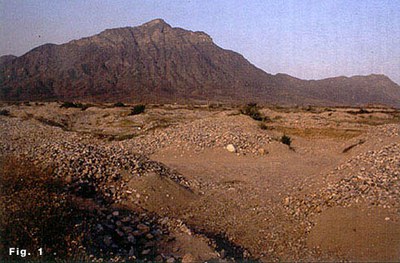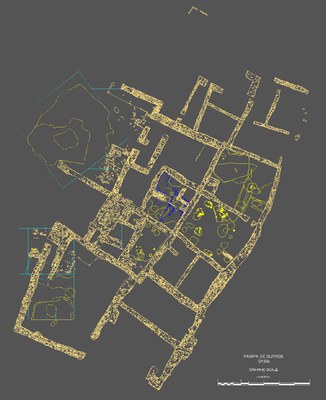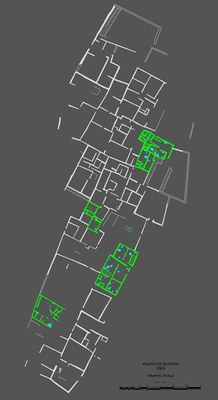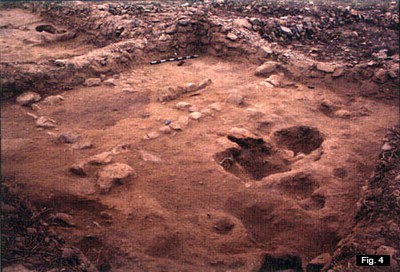Current models of Central Andean social organization, based upon ethnohistoric sources on Inka society, paint a picture of self-sufficient villages, with little horizontal exchange among them and occupational specialization limited to attached specialists working on behalf of the state. In sharp contrast, a spotty ethnohistorical record from the North Coast points to an advanced division of labor, with extended kin groups (parcialidades) of independent specialists engaged in direct exchange of their products. Is this model of coastal social organization supported by the late Prehispanic archaeological record? If so, how far can it be traced back in time, and how are the presumed differences between coastal and highland societies to be explained?
These are the questions addressed by our long-term research in the Lambayeque Valley. An initial survey located an ideal site to tackle the issue of specialization: The S sector (S166) of a 6 ha complex of agglutinated rooms along the ancient Taymi Canal on the Pampa de Burros dates to the Chimú period (AD 1350–1460); partially excavated in 1992, it produced evidence of specialized pottery production far from the centers of Chimú power and with no evidence of state interference. The larger N sector (S165) dates to the Middle Sicán period (AD 900–1100); here, a bottle mold fragment suggested the possibility of specialized crafts.

Since its discovery in 1991, squatters, agriculture, and mining have progressively encroached upon this unique site. Mechanized agriculture has erased all archaeological remains south of the Taymi and parts of the Chimú occupation north of the canal. The quebrada just east of the site has been turned into an ugly moonscape by numerous small-scale gravel mining operations (Fig. 1). The eastern edge of the Middle Sicán sector has already fallen prey to mining, and there are several open pits in the heart of the site.

During the 1999 field season, both squatters and gravel trucks had to be expelled from the site on an almost daily basis. Given these imminent threats, our 1999 fieldwork constituted a salvage operation, and documentation was a paramount goal. Within this framework, we pursued two research objectives. Firstly, to clarify the nature of the Chimú pottery workshop (Fig. 2), which previous excavations had shown to be an extremely rich resource. Was it a factory-like facility or a workshop-plus-residence, and what was the scale of this enterprise? We excavated four additional rooms (90 sq. m) of the structure as well as two rooms (61 sq. m) at the adjacent S166b to elucidate the relationship of this likely residential structure to the nearby pottery workshop. Secondly, we investigated the previously unexcavated northern sector (S165) for evidence of specialized crafts from the Middle Sicán period. Our plan was to infer potential household units from repetitive architectural features and access patterns and to study the domestic economies of a sample of these households. Therefore, we cleared, wall-trenched, and mapped a complex of 125 contiguous rooms (0.44 ha) and subsequently selected four groups of rooms (336 sq. m) for excavation.
At the Chimú pottery workshop, we found a bewildering variety of fire pits in all the excavated rooms, even the smallest, inner ones, which had been expressly targeted as likely domestic spaces. In each room and stratum, there are one large and several small, shallow hearths, none of which produced appreciable amounts of food remains. Thus, the large hearths are likely to be open-pit kilns, like two previously excavated ones, while the small ones probably served for preheating vessels.
Judging from the numerous kilns and the lack of postholes, most of the workshop spaces would have been walled-off patios. Clearly, then, nobody lived in this structure, and the separation of living and workspace, commonly regarded as a hallmark of the Industrial Revolution, may be a considerably older phenomenon. In light of a few mold fragments found at the adjacent S166b, which is entirely domestic, this may have been the potters' residence. Although there is only one vessel-shaping area (excavated in 1992), the presence of multiple, stratigraphically contemporary kilns at a dedicated workshop facility points to several, expert potters and an operation of considerable size. Apparently, Donax was the potters' favorite snack; they tossed more than 8,000 of these small seashells onto the patios. At 50 km from the shore, seashells may have been a preferred item traded for pottery vessels.

Within the Middle Sicán complex (S165, Fig. 3), only one potential household unit
seemed reasonably obvious, albeit quite large (130 sq. m) for a single residence. However, instead of the expected evidence of domestic activities, we uncovered multiple fire pits and ash lenses in all rooms. Most of the ash lenses are quite shallow, consist of clean ash without any food remains, and show little or no evidence of in situ burning. Typically, one fire pit in a corner is somewhat deeper and has a fire-reddened bottom. In addition, we found several worn hammer stones and tiny fragments of extremely thin copper sheets. These fragments, as well as feathers
made of sheet copper—some apparently unfinished—and a small copper chisel were found all across the complex.

All the evidence described is compatible with the manufacture of sheet-copper ornaments as the primary activity performed in this unit. Hot ashes would have been carried from the corner hearths to the center floor in order to heat copper before hammering it into sheets. These preheating loci would have been ephemeral and moved frequently. The smelting or melting of raw copper, a dirty and hazardous activity, occurred at some distance from the inhabited complex: Underneath the Chimú pottery workshop, in a layer associated with Sicán pottery, we found the crushed remains of two small furnaces full of what appears to be copper slag. (Fig. 4).
The alleged metal workshop is part of a sector of relatively large spaces with few subdivisions, south of a central plaza. North of the plaza, rooms are smaller and more densely packed. One suite
and two rooms excavated in this sector clearly were residential, with storage vessels, small corner storerooms, a kitchen, and a bedroom with a sleeping bench. The small corner storerooms are the only repetitive architectural feature, and they are decidedly more common to the north than to the south of the central plaza, supporting a functional division of the complex into a northern residential sector and workspaces to the south. No other subdivisions within the 125-room complex are evident, and the structure is entirely self-contained, lacking any connections to adjacent room complexes. This layout is suggestive of the residence of a single corporate group. Moreover, judging from the restricted distribution of graters, kitchen facilities may have been communal.
These findings are consistent with the ethnohistoric record of parcialidades of specialists. If confirmed by analyses of materials and hopefully further excavations at the site, the division of labor and the socioeconomic organization described in contact period documents would go back at least as far as the Middle Sicán period.